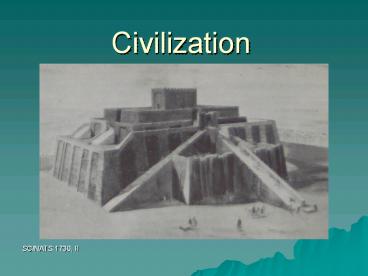Civilization - PowerPoint PPT Presentation
Title:
Civilization
Description:
Cuneiform, contd. The clay tablets were left to dry in the sun, and became very durable. There are thousands of cuneiform tablets still in existence. ... – PowerPoint PPT presentation
Number of Views:18
Avg rating:3.0/5.0
Title: Civilization
1
Civilization
2
Civilization Requires Organization
- In pre-agricultural societies, as soon as there
was enough food for all, work stopped. - With agriculture, a field must be sown, tended,
and later harvested all at once. - The harvest must be stored.
- Domestic animals must be maintained as a herd.
3
The Surplus
- When all goes well, there will be a surplus of
food that is not immediately distributed. - It is valuable, and must be managed and guarded.
4
Bureaucracy
- With the Agricultural Revolution comes
- Government bureaucracy
- Standing armies
- A controlling social elite
5
Trades
- Not all people had to farm. Some could become
specialists in particular tasks - Potters
- Tool makers
- Metal workers (smiths)
- Bakers, butchers, etc.
- Bureaucrats and priests (often the same people)
6
Agricultural Improvements
- Saving and scattering seed produces a crop, but
the crop could be greatly improved by breaking up
the soil and getting the seeds just below the
surface. - Two inventions in different parts of the world
solved that problem differently.
7
The Plough
- In the Middle East, north Africa, and the
Mediterranean, the simple ploughor scratch
ploughwas invented. - It cut a furrow in the ground into which seeds
were thrown, and then covered over. - This is often called the most important invention
of all time.
8
The Seed Drill
- In the Orient, a different solution to the same
problem was a machine that pushed a few seeds
directly into the ground in evenly spaced rows.
9
Irrigation
Shadoofs, water-raising devices.
- An innovation of greater significance even than
the plough and the seed drill was the concept of
irrigation Bringing water to the crops, not just
waiting for rain or floods.
10
Irrigation Leads to Government
- Even if a farming society had begun to flourish
with relatively independent farmers, once
irrigation is introduced, infrastructure follows. - An irrigation ditch and water-raising devices are
large, expensive projects, requiring government,
taxation, etc.
11
The Fertile Crescent
- The first area of the world to move to an
agricultural way of life was near where Africa,
Europe, and Asia meet.
12
Why There?
- The Fertile Crescent is fertile, because rivers
from all three continents drain into it, bringing
rich nutrients to the soil as well as water. - It was also in an area of moderate climate,
perfect for growing crops. - For those reasons it was also more heavily
populated.
13
Mesopotamia
- The worlds first great civilization arose in the
Fertile Crescent. - This happened in particular in an area that is
now part of Iraq. - This area is bounded by the Tigris and the
Euphrates rivers. - The Greeks called it Mesopotamia, meaning
between the rivers.
14
Sumer
- The first notable civilization in Mesopotamia was
Sumer. - It was located in southern Mesopotamia, near
where the rivers join.
15
Early Settlements
- The earliest known settlement in the Euphrates
floodplain dates from before 5000 BCE. It is
characterized by large villages and temples. - Relatively rapid development is attributed to the
use of irrigation.
16
Historical Sumer
- The known history of Sumer begins in 2900 BCE,
with the invention of writing.
17
Cuneiform
- The Mesopotamian area was rich in clay and in
reeds that grew on the river banks. - They were combined to make a medium for writing.
18
Cuneiform, contd.
- Clay was formed into a slab, about the size of a
human hand. - The reed stalks were cut to make a stylus.
- The stylus was pushed into the wet clay in a
variety of different ways to make recognizable
marks, carrying meaning.
19
Cuneiform, contd.
- The clay tablets were left to dry in the sun, and
became very durable. - There are thousands of cuneiform tablets still in
existence. - Hence, much is known about the history of these
settlements.
20
Sumerian Culture
- The Sumerians were very well organized and had a
complex bureaucracy, ruled by the priests in the
temples. - All the major trades of pre-industrial times
developed there.
21
The Downside of Sumerian Culture
- The trend to rapid urbanization and blight of the
environment that followed was characteristic. - Fertile soils were quickly depleted by over use.
- Over-irrigation led to salinization.
- The accumulation of wealth attracted raiders. The
area has been a battleground ever since.































